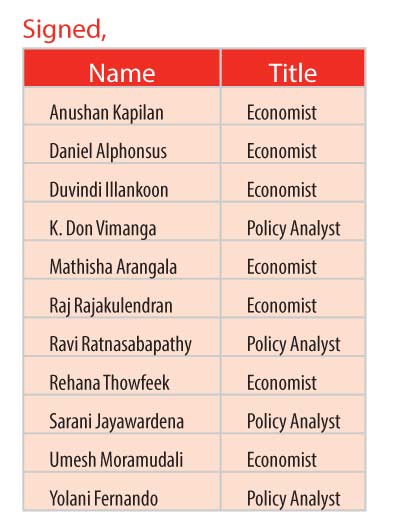Saturday Apr 19, 2025
Saturday Apr 19, 2025
Thursday, 17 April 2025 00:00 - - {{hitsCtrl.values.hits}}
Sri Lanka exported $ 3 billion to the United States last year—nearly a quarter of our total exports. These exports, and the jobs they support, will be at serious risk if recently announced US tariffs come into effect. Production is likely to shift to countries facing lower tariff hikes, such as India, Kenya, and Egypt.
In response, the Sri Lankan Government will present a plan to reduce the country’s effective tariff rate. This is welcome. It is well understood that a tax on imports is a tax on exports. For nearly two decades, Sri Lankan exporters have been weighed down by exceptionally high import tariffs. This marks a sharp break from the 1990s, when our average tariff rates were comparable to Indonesia, Malaysia, and the Philippines—and lower than China, Thailand, and Vietnam. Unsurprisingly, this was when Sri Lanka’s exports were at their peak: our share of world exports reached its highest point at the dawn of the new millennium. Even then, benchmarking against large Asian economies isn’t good enough. As a small economy aspiring to be the Indian Ocean’s trading hub, we should, in the first instance, benchmark our tariffs to the UAE, Singapore and Hong Kong.
Successive plans to reduce tariffs have failed to materialise, enriching the few at the expense of the many. An accelerated reduction is now essential. The Government must now proceed to eliminate para-tariffs, reduce tariffs, and simplify our tariff structure. It must also address non-tariff barriers via the long awaited Customs Act, and full implementation of the National Single Window and WTO Trade Facilitation Agreement. It must not be swayed by the private interests of a few businessmen or officials.
Beyond strengthening our negotiating position with the US and supporting export growth, these reforms will reduce input costs for businesses and prices for consumers—offering partial relief from the fallout of US tariffs. This may also create space for the Central Bank to reduce interest rates and facilitate depreciation of the rupee, thus improving export competitiveness.
The tariff shock is a stark reminder that Sri Lanka’s export products and markets have changed little since the early 1980s. No substantial manufactured or agricultural exports have emerged since then. This lack of product diversification is a key reason for our market concentration.
Expanding our export basket and entering new markets is urgent—but also difficult in a time of economic turmoil. Integrating into regional and global supply chains is critical. Concluding or strengthening FTAs with India, China, and ASEAN—and ultimately joining RCEP—should be a priority. Sri Lanka currently doesn’t have the trade negotiation capacity to negotiate many agreements at once. In addition to operationalising the Office of International Trade, as with the debt restructuring process, we must hire the world’s top trade negotiators to advise us.
More broadly, we must prioritise exports not just in word, but also in deed. That means removing barriers to export-oriented foreign investment —including reforms to labour, land and energy markets— and, considering the Government’s fiscal constraints, unlocking foreign investment in export-enabling infrastructure such as industrial zones, freight forwarding, urban transportation, power plants, airports, high-density housing and universities.
The US tariff shock is not just a short-term threat, but yet another wake-up call to confront long-standing structural weaknesses. Over the last few years we have seen the results of our own complacency. As the world economy becomes ever more tumultuous, we cannot afford such myopia again. Sri Lanka needs a laser focus on reducing costs and improving competitiveness. Slashing tariffs, signing FTAs, reforming factor markets and building export infrastructure, integrated together, can propel Sri Lanka to compete, and win, on the world market.
 Priority actions:
Priority actions:
1. Accelerate PAL and other paratariff phase-out
2. Reduce and simplify tariffs
3. Pass Customs Act, fast-track National Single Window and WTO Trade Facilitation Agreement full implementation
4. Conclude ETCA and China FTA negotiations
5. Operationalise Office of International Trade
6. Initiate ASEAN FTA and other bilateral FTA negotiations
7. Prioritise export-oriented infrastructure in the Public Investment Pipeline and create an export-oriented infrastructure PPP pipeline
8. Initiate structural reforms in land, labour and energy markets
Discover Kapruka, the leading online shopping platform in Sri Lanka, where you can conveniently send Gifts and Flowers to your loved ones for any event including Valentine ’s Day. Explore a wide range of popular Shopping Categories on Kapruka, including Toys, Groceries, Electronics, Birthday Cakes, Fruits, Chocolates, Flower Bouquets, Clothing, Watches, Lingerie, Gift Sets and Jewellery. Also if you’re interested in selling with Kapruka, Partner Central by Kapruka is the best solution to start with. Moreover, through Kapruka Global Shop, you can also enjoy the convenience of purchasing products from renowned platforms like Amazon and eBay and have them delivered to Sri Lanka.
Discover Kapruka, the leading online shopping platform in Sri Lanka, where you can conveniently send Gifts and Flowers to your loved ones for any event including Valentine ’s Day. Explore a wide range of popular Shopping Categories on Kapruka, including Toys, Groceries, Electronics, Birthday Cakes, Fruits, Chocolates, Flower Bouquets, Clothing, Watches, Lingerie, Gift Sets and Jewellery. Also if you’re interested in selling with Kapruka, Partner Central by Kapruka is the best solution to start with. Moreover, through Kapruka Global Shop, you can also enjoy the convenience of purchasing products from renowned platforms like Amazon and eBay and have them delivered to Sri Lanka.